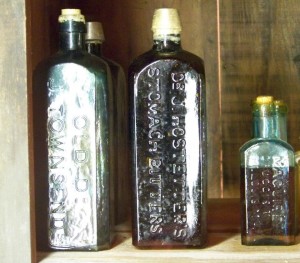What are stomach bitters? Twenty-three bottles of bitters were among the medicines of questionable effectiveness that sank on the Arabia in 1856. Bitters are still available (and rising in popularity) today, although their function has evolved. In the past, bitters were used medicinally—at least in theory—but today they are part of the classic cocktail trend.

From left: Old Dr. J. Townsend’s Sarsaparilla (a type of bitters and ancestor of modern-day root beer), Dr. J. Hostetter’s Stomach Bitters, and a medicine manufactured by Maguire Druggist in St. Louis, MO
An 1856 advertisement for Dr. J. Hostetter’s Stomach Bitters boasts the following benefits, “a sure cure for dyspepsia; will remove all flatulency or heaviness from the stomach, keep you free from costiveness, assist digestion, give a good appetite, impart a healthy tone to the whole system, and is a certain preventive of fever and ague.”
…but what exactly is this supposed miracle cure?
Bitters are essentially alcohol infused with bitter herbs.
An 1859 recipe for “Stomach Bitters Equal to Hostetter’s for One-Fourth Its Cost” calls for gentian root, orange peel, cinnamon, anise seed, coriander seed, cardamom seed, Peruvian bark, and gum kino, steeped in alcohol for 2 weeks and strained before mixing with sugar and water.
Indeed, gentian—the star ingredient in most bitters preparations, even today—has been known for centuries to have stomach-soothing properties. However, the very high alcohol content of bitters probably outweighed any potential medical benefit. Dr. Hostetter’s original formula, for example, was about 47% alcohol (94 proof)! Unfortunately, the medical industry lacked regulation or oversight in the 19th century, and manufacturers could avoid stiff tax rates by marketing their booze as medicines. However, taxes became unavoidable by the turn of the 20th century, and Prohibition almost destroyed the Bitters industry.
A few 19th-century brands of bitters are still in production, including the ever-popular Angostura. With the rise of the post-Prohibition cocktail culture in the United States, bitters were rarely taken straight (or medicinally) but were an important flavoring component in drinks like the Manhattan, the Old Fashioned, and Pink Gin.
Today, classic cocktails are making a comeback in a big way, causing a resurgence of demand for bitters. In fact, a 2009 shortage of Angostura bitters made news headlines. Trendy bartenders are going to great lengths to procure antique bottles of bitters or develop brand-new flavors. While they may not actually cure your fever, bitters are sure to add depth and complexity of flavor—along with a dash of history—to any cocktail.
Sources/Further Reading:
Thurston, George Henry. Directory of Pittsburgh and Allegheny cities, etc. Harvard, 1856. http://books.google.com/
Chase, Alvin Wood, M.D. Information for everybody: An invaluable collection of over one hundred and fifty practical recipes for business and professional men, mechanics, artists, farmers, and for families generally. University of Michigan, 1859. http://books.google.com/
“Prohibition Bitters,” New York Times. July 28, 1884. http://query.nytimes.com/
Klamkin, Marian. The Collector’s Book of Bottles. California: Dodd, Mead, 1971 (see pages 99-103).
Ellwood, Mark. “The Bitters Truth,” Departures. September 2007. <http://www.departures.com/